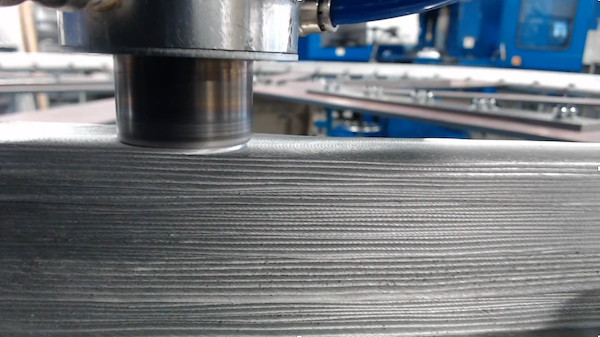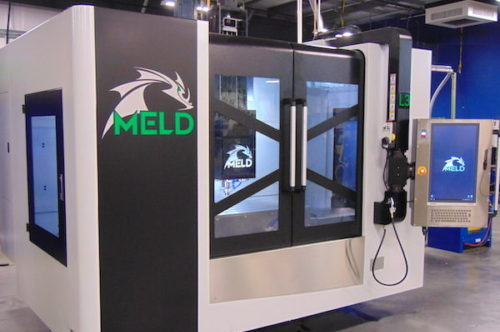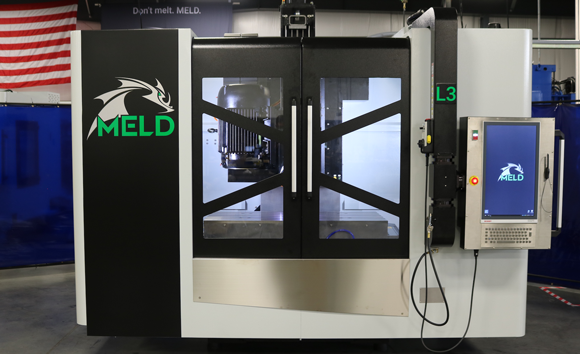Virginia-based company MELD Manufacturing Corporation, a subsidiary of Aeroprobe Corporation, came bursting onto the 3D printing scene in 2018, when it won the RAPID Innovation Award just a month after its formal launch. MELD was formed as a way to continue work on Friction Stir Additive Manufacturing (AFS-D), the novel technology that Aeroprobe and the Edison Welding Institute developed together that can print functionally gradient metal components using only pressure and friction—not lasers—to heat the materials. The company’s first printer, offering what the website calls “extreme material flexibility,” was the B8, followed by the K2, designed to fabricate and repair large parts, and now it’s introducing another system to its range of metal 3D printers, the new L3 MELD.
Combining the features and aesthetics of the larger MELD K2 printer (82 cubic foot build volume) with a lower cost and smaller size, but bigger than the MELD B8 (3 cubic foot build volume), the L3 model has a 14.2 cubic feet (45 x 23 x 23 in) build model, and a 51 x 23 in table for fixturing parts.
“L3 offers a generous workspace and build volume for manufacturing with increased access for fixturing. This machine offers a tremendous increase in production capability without requiring a larger footprint on the manufacturing floor,” the MELD website states.
MELD’s patented, award-winning AM technology does not actually melt the material when it’s repairing, coating, joining, or 3D printing metals and metal matrix composites. It’s a solid-state process, so the printers just heat the materials up so they deform enough to be shaped, without worrying about hot-cracking or porosity issues. The MELD process uses less energy than melt-based ones, but the company says it’s able to print high-quality, full-density parts with low residual stress, and no post-processing techniques, like sintering or hot isostatic pressing (HIP), or sintering, are needed once the part is off the build plate.
“When we look at our customers and what they want to do with the technology it was clear that there needed to be a machine with a platform perfect for both part fabrication and repair,” explained Dr. Chase Cox, the Director of Technology for MELD Manufacturing Corporation. “The L3 serves that need, offering a tremendous increase in production capability without requiring a larger footprint on the manufacturing floor.”
MELD boasts an open-air, or open-atmosphere, process, which means no pricey vacuum systems or small powder beds: the method is not sensitive to the condition of the material’s surface or the operating environment, which means a scalable process and simpler requirements for safety equipment, usability, material, and operating costs. Combined, these features make all of MELD’s 3D printers easier to use in real-world manufacturing situations, and the machines can also produce bigger parts at a higher rate of speed in a wide variety of metal materials, from titanium and aluminum to steel, copper, and nickel-based super alloys.
“MELD-deposited materials don’t just look great, they also exhibit exceptional mechanical properties that meet or exceed material specification. This means that your MELDed material will behave as expected, allowing your designs to be limited only by your imagination and not by your additvely-manufactured material,” MELD states on its website.
MELD’s new L3 system has a lower price than the the larger K2, which makes it an even more enticing choice for customers looking to grow their metal 3D printing portfolio. The MELD L3 printer is the third product that the company, which is owned entirely by women, has introduced to the market in the three years since it’s opened the doors, so I’m excited to see what they do next.
(Source/Images: MELD Manufacturing Corporation)
Subscribe to Our Email Newsletter
Stay up-to-date on all the latest news from the 3D printing industry and receive information and offers from third party vendors.
You May Also Like
3D Printing Unpeeled: New Arkema Material for HP, Saddle and Macro MEMS
A new Arkema material for MJF is said to reduce costs per part by up to 25% and have an 85% reusability ratio. HP 3D HR PA 12 S has been...
3D Printing News Briefs, January 20, 2024: FDM, LPBF, Underwater 3D Printer, Racing, & More
We’re starting off with a process certification in today’s 3D Printing News Briefs, and then moving on to research about solute trapping, laser powder bed fusion, and then moving on...
3D Printing Webinar and Event Roundup: December 3, 2023
We’ve got plenty of events and webinars coming up for you this week! Quickparts is having a Manufacturing Roadshow, America Makes is holding a Member Town Hall, Stratafest makes two...
Formnext 2023 Day Three: Slam Dunk
I’m high—high on trade show. I’ve met numerous new faces and reconnected with old friends, creating an absolutely wonderful atmosphere. The excitement is palpable over several emerging developments. The high...


































